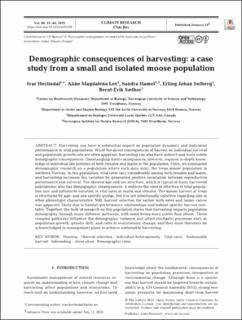| dc.description.abstract | ABSTRACT: Harvesting can have a substantial impact on population dynamics and individual performance in wild populations. While the direct consequences of harvest on individual survival and population growth rate are often apparent, harvesting can also have indirect and more subtle demographic consequences. Disentangling these consequences, however, requires in-depth knowledge of individual life histories of both females and males in the population. Here, we summarise demographic research on a population where such data exist: the Vega moose population in northern Norway. In this population, vital rates vary considerably among both females and males, and harvesting increases this variation by generating positive covariation between reproductive performance and survival. The skewed age and sex structure, which is typical of many harvested populations, also has demographic consequences: it reduces the ratio of effective to total population size and influences variation in vital rates in males and females. The moose harvest at Vega is structured by age- and sex-specific quotas, but it is not intentionally selective regarding size or other phenotypic characteristics. Still, harvest selection for earlier birth rates and larger calves was apparent, likely due to habitat-performance relationships and habitat-specific harvest mortality. Together, the bulk of research on this population shows that harvesting impacts population demography through many different pathways, with some being more subtle than others. These complex pathways influence the demographic variance and affect stochastic processes such as population growth, genetic drift, and rates of evolutionary change, and they must therefore be acknowledged in management plans to achieve sustainable harvesting. | en_US |

